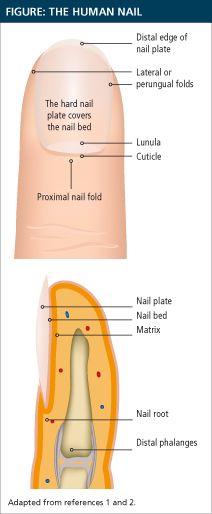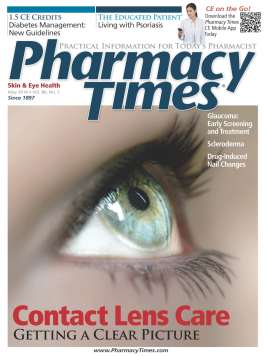Publication
Article
Pharmacy Times
Drug-Induced Nail Changes: Counting to 10
Author(s):
Patients' nails can reveal health issues as well as side effects of medication.
Patients’ nails can reveal health issues as well as side effects of medication.
To the trained eye, patients’ nails can reveal secrets. Chewed nails suggest anxiety, buffed nails hint at good grooming, stained nails identify a smoker, blue nails connote oxygen deprivation, and spoon-shaped nails often mean that a patient needs more vitamin B12. Nail changes can also develop as a side effect of medication or illness.

The nail has several parts (Figure1,2), and a working familiarity with nail “vocabulary” can help pharmacists identify specific nail changes. Drug-induced nail changes can perplex even expert dermatologists, however. Most drug-induced nail changes occur when a drug affects the nail epithelia, but drugs can also affect the nail matrix, the nail bed, or the periungual tissue. Drug-induced changes may accumulate in, and discolor, the nail or surrounding skin. Certain medications change digital perfusion, leading to necrosis or blood vessel damage. Topical exposure to drugs can cause dyschromias and irritant or allergic contact dermatitis. Some drugs affect more than 1 area.1 Let’s look at 10 types of drug-induced nail changes. The Online Table1-25 describes drugs associated with these alterations.
- Beau’s lines—grooved, side-to-side (horizontal) depressions in the nail surface—most often occur if a drug decreases keratinocyte cell division in the proximal nail fold. The depth of the depression reflects the amount of damage, and the depression length increases as drug exposure increases.3 Usually, Beau’s lines appear on all 20 nails within weeks of starting treatment. A common side effect of chemotherapy and radiation, multiple Beau’s lines will develop with repeated chemotherapy cycles; between treatment cycles, the nails return to normal. Human fingernails typically grow at about 0.1 mm/day (toenails grow at half that rate); as nails grow, Beau’s lines move upward and are eventually snipped off.1,3,4 Onychomadesis—nail shedding or splitting—is an extreme degree of Beau’s lines.5
- Leukonychia, also called milk spots, occurs when drugs affect keratinization. True leukonychia is the most common color abnormality of the nail, and it can present as spots, lines, or incomplete to total nail whitening.1,6 In most cases, it’s the result of a minor injury. When drug related, it usually occurs in all nails simultaneously as 1- to 2-mm horizontal bands. Chemotherapy is a frequent cause. A series of thin bands (called Mees’ lines) reveals arsenic poisoning.6-9
- Nail thinning and fragility may present as lamellar onychoschizia, in which the nail’s upper layers detach, or as elkonyxis, in which the nail loses substance and becomes soft or pitted. Affected patients have a greater risk of ingrown toenails and multiple periungual pyogenic granulomas (discussed below).10,11
- Onycholysis—separation of the nail plate from its bed—creates a space that usually appears white. The cause may be dose related, drug-induced thrombocytopenia, vascular abnormalities, direct nail bed toxicity, or peripheral nerve damage. Dosage reduction of the offending drug can help, and this condition usually regresses over several months after drug discontinuation.1,12
- Photoonycholysis—an allergic or toxic effect of ultraviolet radiation that separates the nail plate from the nail bed—occurs in 3 subtypes: A half-moon—shaped distal onycholysis surrounded by a pigmented zone A proximal circular notch A separation in the central nail that spares the lateral portion of the nail, often in association with hemorrhages beneath the nail Considered rare, drug-induced photoonycholysis affects several fingers but spares the thumbs, and it can be painful. It results from drug exposure and exposure to natural sunlight or artificial light (eg, photochemotherapy).13,14 Photoonycholysis can occur after drug treatment if the drug remains in the skin. It usually regresses after discontinuation of the causative agent; the agents most often associated with photoonycholysis also often cause phototoxicity. Applying opaque nail polish and avoiding sun exposure can prevent this effect.1,12
- Paronychia (erythematous, swollen, painful nail folds) and pyogenic granuloma (a vascular tissue overgrowth) are often drug induced but stem from the same cause. Decreased attachment between nail keratinocytes creates scales below the proximal nail plate and a subsequent foreign body inflammation reaction.15,16 One or more nails may be affected, usually shortly after treatment starts. These nails heal after the drug is withdrawn, and onychomadesis (discussed in #1 above) often follows. If the drug must be continued, clinicians prescribe topical antiseptics, antibiotics, and steroids for symptomatic relief. Some evidence indicates that wearing frozen socks and gloves during drug infusion may reduce this problem. Cooling cells restricts blood flow, making the nails less likely to be affected by toxic drugs.
- Hemorrhage or ischemic changes. Drugs can alter nail vessels, causing hemorrhage or ischemic changes. Toenails are more prone to the former because they suffer mechanical trauma more often than do fingernails.1 Ischemic changes occur in a full range of severities, from a Raynaud-like presentation to digital gangrene, which is more likely in patients with severe peripheral vascular disease. These changes may be reversible.1,17
- Melanic pigmentation can occur in 2 ways. Drugs that activate a group of melanocytes produce single longitudinal pigmented bands (melanonychia) that alternate with normal color, but drugs that activate melanocytes diffusely discolor the entire nail. Usually, the pigment is brown to black.18,19
- Nonmelanic pigmentation occurs when the nail matrix extracts the drug and stores it in the nail, or the drug deposits in the nail or subungual area. The nail may turn blue, brown, or gray, depending on the drug, and the color will grow out as the nail does.1,20,21
- Irritant or allergic reactions. Topical agents sometimes cause nail changes, with irritant or allergic reactions being the most common. Symptoms include redness, itching, hives, blistering, and pain under and near the nail.22-25
Table: Drugs Associated with Nail Changes
Nail Change
Nail Area Affected
Potential Causes
Beau’s lines
Nail matrix
Mechanical insult
Drugs: chemotherapy (docetaxel, cyclophosphamide), retinoids, interferons
Onychomadesis (nail brittleness from severe Beau’s lines)
Nail matrix
Infections: scarlet fever, hand-foot-and-mouth disease, or Kawasaki disease
Systemic reactions: Stevens-Johnson syndrome and pemphigus
Drugs: high-dose chemotherapy, carbamazepine, lithium carbonate, valproic acid, high-dose cephaloridine, and cloxacillin
Leukonychia
Nail matrix
Poisonings: sulfamide, pilocarpine, carbon monoxide, heavy metals (especially arsenic)
Drugs: chemotherapeutic drugs (eg, cyclophosphamide, vincristine, doxorubicin)
Disease: Hodgkin’s disease, hypocalcemia, pneumonia, psoriasis, renal or hepatic failure, sickle cell anemia, and helminthic infections
Nail thinning and fragility
Nail matrix
Drugs: chemotherapy, retinoids
Onycholysis
Nail bed
Infections: hand-foot-and-mouth disease
Drugs: taxanes (eg, docetaxel, paclitaxel), anthracyclines (eg, doxorubicin), bleomycin, immunosuppressive drugs (eg, sirolimus, rituximab), tetracyclines
Photoonycholysis
Nail bed
Disease: porphyrias
Drugs: aminolevulinic acid (photodynamic therapy), thiazide diuretics, clorazepate dipotassium, fluoroquinolones, griseofulvin, olanzapine and aripiprazole, psoralens, quinine, tetracyclines
Paronychia and pyogenic granuloma
Periungual folds
Drugs: taxanes, retinoids (systemic and topical) antiretrovirals (especially indinavir), epidermal growth factor—receptor inhibitors (eg, cetuximab, gefitinib), and capecitabine
Hemorrhage
Nail vasculature
Drugs: taxanes, anthracyclines, immunosuppressive drugs (eg, sirolimus, rituximab), sorafenib, sunitinib, anticoagulants, aspirin, retinoids
Melanic pigmentation
Entire nail
Drugs: chemotherapy, infliximab, zidovudine
Nonmelanic pigmentation
Entire nail
Drugs: tetracyclines (especially minocycline); antimalarial therapy with amodiaquine, chloroquine, mepacrine, or quinacrine
Irritant or allergic reactions
Nail plate
or surrounding tissues
Drugs: urea-containing topical, antifungal drugs
Nail polish and cosmetics used on nails
Adapted from references 1-25.
End Note
Drug-induced nail changes can be solely cosmetic problems, but serious nail changes can be so painful that they impair manual activities or ambulation. Patients may have questions about the changes—their causes, the likelihood they will resolve, and how to treat discomfort if it occurs. It is critical to involve patients’ other caregivers if the changes are significant or impairing.
Ms. Wick is a visiting professor at the University of Connecticut School of Pharmacy.
References
- Piraccini BM, Alessandrini A. Drug-related nail disease. Clin Dermatol. 2013;31:618-626.
- Skin and nail: barrier function, structure, and anatomy considerations for drug delivery. Particle Sciences website. www.particlesciences.com/news/technical-briefs/2009/skin-and-nail.html. Accessed February 11, 2014.
- Park J, Li K. Images in clinical medicine: multiple Beau’s lines. N Engl J Med. 2010:362-363.
- Chang CC, Wu CC. Beau’s lines. QJM. 2013;106:383.
- Eastwood JB, Curtis JR, Smith EK, et al. Shedding of nails apparently induced by the administration of large amounts of cephaloridine and cloxacillin in two anephric patients. Br J Dermatol. 1969;81:750-752.
- Grossman M, Scher RK. Leukonychia. Review and classification. Int J Dermatol. 1990;29:535-541.
- Parakh A, Kocchar AM. Chemotherapy induced transverse leukonychia (Mees, lines). Indian Pediatr. 2007;44:865.
- Antonarakis ES. Images in clinical medicine: acquired leukonychia totalis. N Engl J Med. 2006;355:e2.
- Saray Y, Seckin D, Güleç AT, et al. Nail disorders in hemodialysis patients and renal transplant recipients: a case-control study. J Am Acad Dermatol. 2004;50:197-202.
- Onder M, OztaÅŸ MO, OztaÅŸ P. Isotretinoin-induced nail fragility and onycholysis. J Dermatolog Treat. 2001;12:115-116.
- Piraccini BM, Iorizzo M, Starace M, et al. Drug-induced nail diseases. Dermatol Clin. 2006;24:387-391.
- Chandran NS, Aw DC. Drug-induced photo-onycholysis: an often-neglected phenomenon. Intern Med J. 2013;43:1349-1350.
- Baran R, Juhlin L. Photoonycholysis. Photodermatol Photoimmunol Photomed. 2002;18:202-207.
- Bentabet Dorbani I, Badri T, Benmously R, et al. Griseofulvin-induced photo-onycholysis. Presse Med. 2012;41:879-881.
- Piraccini BM, Bellavista S, Misciali C, et al. Periungual and subungual pyogenic granuloma. Br J Dermatol. 2010;163:941-953.
- Luther J, Glesby MJ. Dermatologic adverse effects of antiretroviral therapy: recognition and management. Am J Clin Dermatol. 2007;8:221-233.
- Manousaridis I, Mavridou S, Goerdt S, Leverkus M, Utikal J. Cutaneous side effects of inhibitors of the RAS/RAF/MEK/ERK signaling pathway and their management. J Eur Acad Dermatol Venereol. 2013;27:11-18.
- Jefferson J, Rich P. Melanonychia [published online June 27, 2012]. Dermatol Res Pract. 2012;2012:952186.
- Paurobally D, El Hayderi L, Richert B, et al. Melanotan-associated transverse melanonychia. J Eur Acad Dermatol Venereol. 2013;27:128-129.
- Tavares J, Leung WW. Discoloration of nail beds and skin from minocycline. CMAJ. 2011;183:224.
- Teive HA, Munhoz RP. Rotigotine-induced nail dyschromia in a patient with Parkinson disease. Neurology. 2011;76:1605.
- Piraccini BM, Alessandrini A, Bruni F, et al. Acute periungueal dermatitis induced by application of urea-containing cream under occlusion. J Dermatol Case Rep. 2012;6:18-20.
- Raulin C, Frosch PJ. Contact allergy to imidazole antimycotics. Contact Dermatitis. 1988;18:76-80.
- Dooms-Goossens A, Matura M, Drieghe J, et al. Contact allergy to imidazoles used as antimycotic agents. Contact Dermatitis. 1995;33:73-77.
- Pérez-Varela L, Goday-Buján J, Piñeyro-Molina F, et al. Allergic contact dermatitis due to amorolfine in nail lacquer. Actas Dermosifiliogr. 2010;101:281-283.







